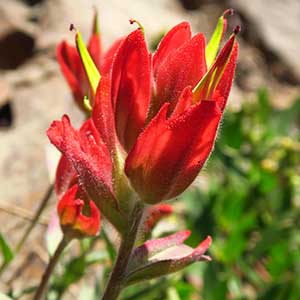Castilleja rupicola
Castilleja elmeri
cliff Indian paintbrush, cliff paintbrush
Elmer's Indian paintbrush, Elmer's paintbrush, Wenatchee Indian paintbrush, Wenatchee paintbrush
many, decumbent to ascending, unbranched, sparsely pubescent, hairs spreading, wavy, fairly short, soft, eglandular, sometimes glabrous proximally.
solitary or few to many, erect to ascending, sometimes slightly curved at base, unbranched, rarely branched, hairs moderately dense, spreading, medium length, soft, mixed with shorter eglandular and stipitate-glandular ones, at least on distal 1/2 of stem.
purple to green, narrowly, rarely broadly, lanceolate, 1.4–4 cm, not fleshy, margins plane, flat to involute, (0–)3–5(–7)-lobed, apex acute to acuminate;
lobes divergent, spreading-ascending, linear, long, not much narrower than mid blade, often with secondary lobes, creating little frilly fans, apex acute or obtuse.
green, rarely purple-tinged, linear-lanceolate, sometimes linear or lanceolate, 1.3–6.5 cm, not fleshy, margins plane, flat or involute, entire, apex acute.
2–6 × 2–3.5 cm;
bracts proximally greenish or deep purple near base, distally red, scarlet, or crimson to red-orange, rarely orange, salmon, pink, or yellowish white, ovate to orbicular in outline, 5(–9)-lobed;
lobes spreading, linear to linear-lanceolate, long, arising below mid length, apex acute to rounded.
2.5–9 × 1.5–3 cm;
bracts red, crimson, scarlet, pink, magenta, red-orange, burnt orange, orange, pale yellow, or whitish throughout, or proximally greenish, distally as stated above, oblong, narrowly obovate, elliptic-oblong, or narrowly ovate, 0(–5)-lobed, rarely with 1 or 2 pairs of short, usually distal lobes;
lobes ascending, lanceolate, very short, arising from distal edge, apex rounded to obtuse.
0 mm.
straight or slightly curved, 25–35(–45) mm;
tube 9–15 mm;
beak exserted, adaxially green, purplish, or yellow-green, 14–22 mm;
abaxial lip deep green, reduced, 0.5–2 mm, 6–12% as long as beak;
teeth incurved to erect, green, 0.5 mm.
straight, 20–33 mm;
tubes 13–18 mm;
beak, and sometimes abaxial lip, partially to fully exserted;
beak adaxially green to yellowish, 8–15 mm;
abaxial lip incurved, green, thickened, 2–3 mm, 20–33% as long as beak;
teeth ascending or incurved, green, 0.5–1 mm.
proximally purple, green, or whitish, distally colored as bract lobes, 15–25 mm;
abaxial and adaxial clefts 8 mm, ca. 40–50% of calyx length, deeper than laterals, lateral 1–5 mm, 10–20% of calyx length;
lobes triangular, apex obtuse or acute.
proximally green to pale green, distally colored as bracts, 15–25 mm;
abaxial and adaxial clefts 5–14 mm, 33–50% of calyx length, deeper than laterals, lateral 1–4 mm, 6–20% of calyx length;
lobes lanceolate to narrowly triangular, apex rounded to obtuse.
= 48.
Castilleja rupicola
Castilleja elmeri
Castilleja rupicola is usually found in the subalpine and lower alpine zones in the Cascade Range from extreme southern British Columbia south to northern Douglas County, Oregon. Though it can be numerous where it occurs, the species as a whole is uncommon. One atypical population occurs in a moist, shaded, mossy, north-facing ravine on the Oregon side of the Columbia River Gorge, at less than 250 m. These plants often bear secondary divisions on deeply dissected leaves and bracts.
(Discussion copyrighted by Flora of North America; reprinted with permission.)
The bracts and inflorescences of Castilleja elmeri can be red, crimson, scarlet, pink, magenta, red-orange, burnt orange, orange, pale yellow, or whitish. While the coloration is highly variable between local populations, it is usually uniform and consistent within them. It is found primarily in the Wenatchee Mountains of Washington, where it is often on serpentine, but it ranges northward in the Cascades into extreme southern British Columbia, apparently on non-serpentine substrates. Hybrids with C. miniata var. miniata, C. parviflora var. albida, and C. thompsonii have been found in the eastern Cascades of Washington, and a similar hybrid swarm with C. thompsonii is reported from southern British Columbia.
(Discussion copyrighted by Flora of North America; reprinted with permission.)



